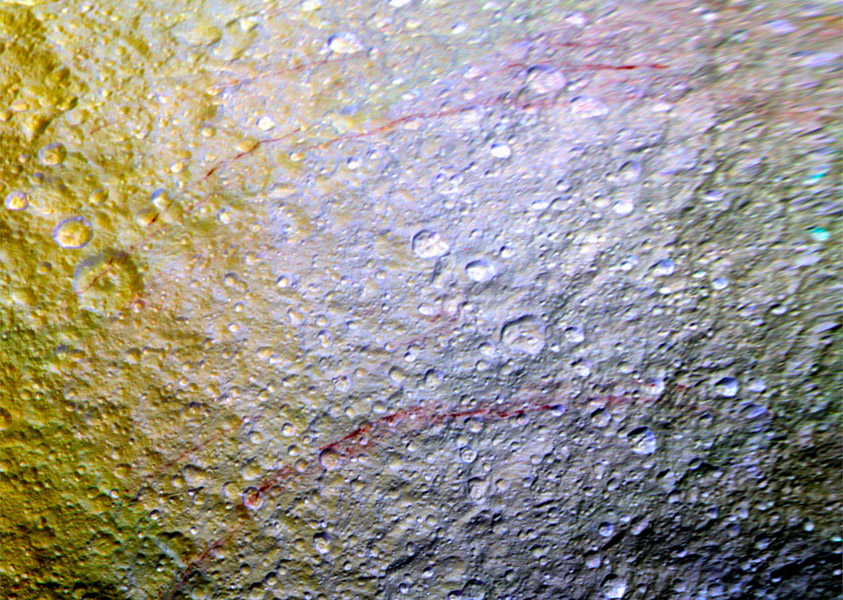It looks like you're using an Ad Blocker.
Please white-list or disable AboveTopSecret.com in your ad-blocking tool.
Thank you.
Some features of ATS will be disabled while you continue to use an ad-blocker.
7
share:
NASA has released an image of Tethys and Enceladus that captures the moment the two Moons aligned to form a Bullseye in space , the image was captured
on Sept 24th using the spacecraft’s narrow-angle camera.
a reply to: gortex
And so the ballet cosmic continues.
These interesting conjunctions serve little purpose in my eyes, save to remind us that the patch of universe in which we live, is a delicately balanced clockwork, and worth feasting ones eyes upon as often as possible, for the simple reason that to look upon its majesty is to be struck dumb by it, and that sensations of that sort are worth pursuing for their own sake.
And so the ballet cosmic continues.
These interesting conjunctions serve little purpose in my eyes, save to remind us that the patch of universe in which we live, is a delicately balanced clockwork, and worth feasting ones eyes upon as often as possible, for the simple reason that to look upon its majesty is to be struck dumb by it, and that sensations of that sort are worth pursuing for their own sake.
a reply to: gortex
I'm sure that you have seen this but...there are red streaks on Tethys

LINK
A mystery!
There may be a clue!
Or not, when simulations were performed, it didn't match up...
Anyway, very interesting and thanks for giving me something to look into!
I'm sure that you have seen this but...there are red streaks on Tethys

LINK
The red streaks were faintly visible in early images from NASA’s Cassini spacecraft, which swooped into the Saturn system in 2004. But it wasn’t until April that Cassini got a close look at the extraterrestrial artwork. Now, after a close flyby in November, scientists can peer even more closely at the smudges. And what they’re finding doesn’t make a lot of sense.
A mystery!
One thing is clear, though: The streaks are relatively young. Normally, dust from Saturn’s E ring and charged particles from space would erase the smudges. But they’re still there. And, they’re drawn on top of the Odysseus basin, meaning that the crater came first
There may be a clue!
When Schenk mapped the lines onto the moon’s surface, he saw a pattern suggesting the moon is being squeezed or deformed by some kind of global stress – such as irregular rotation, a shifting orbit, or the migration of its poles.
Or not, when simulations were performed, it didn't match up...
Anyway, very interesting and thanks for giving me something to look into!
new topics
-
George Knapp AMA on DI
Area 51 and other Facilities: 53 minutes ago -
Not Aliens but a Nazi Occult Inspired and then Science Rendered Design.
Aliens and UFOs: 1 hours ago -
Louisiana Lawmakers Seek to Limit Public Access to Government Records
Political Issues: 3 hours ago -
The Tories may be wiped out after the Election - Serves them Right
Regional Politics: 4 hours ago -
So I saw about 30 UFOs in formation last night.
Aliens and UFOs: 6 hours ago -
Do we live in a simulation similar to The Matrix 1999?
ATS Skunk Works: 7 hours ago -
BREAKING: O’Keefe Media Uncovers who is really running the White House
US Political Madness: 7 hours ago -
Biden--My Uncle Was Eaten By Cannibals
US Political Madness: 8 hours ago -
"We're All Hamas" Heard at Columbia University Protests
Social Issues and Civil Unrest: 8 hours ago -
The good, the Bad and the Ugly!
Diseases and Pandemics: 10 hours ago
top topics
-
BREAKING: O’Keefe Media Uncovers who is really running the White House
US Political Madness: 7 hours ago, 22 flags -
Biden--My Uncle Was Eaten By Cannibals
US Political Madness: 8 hours ago, 18 flags -
African "Newcomers" Tell NYC They Don't Like the Free Food or Shelter They've Been Given
Social Issues and Civil Unrest: 14 hours ago, 12 flags -
George Knapp AMA on DI
Area 51 and other Facilities: 53 minutes ago, 9 flags -
Two Serious Crimes Committed by President JOE BIDEN that are Easy to Impeach Him For.
US Political Madness: 16 hours ago, 9 flags -
Russia Flooding
Fragile Earth: 15 hours ago, 7 flags -
911 emergency lines are DOWN across multiple states
Breaking Alternative News: 16 hours ago, 7 flags -
"We're All Hamas" Heard at Columbia University Protests
Social Issues and Civil Unrest: 8 hours ago, 7 flags -
Russian intelligence officer: explosions at defense factories in the USA and Wales may be sabotage
Weaponry: 13 hours ago, 5 flags -
So I saw about 30 UFOs in formation last night.
Aliens and UFOs: 6 hours ago, 5 flags
7
